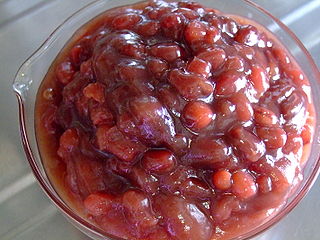
Pastry refers to a variety of doughs, as well as the sweet and savoury baked goods made from them. These goods are often called pastries as a synecdoche, and the dough may be accordingly called pastry dough for clarity. Sweetened pastries are often described as bakers' confectionery. Common pastry dishes include pies, tarts, quiches, croissants, and pasties.

Gyeongju, historically known as Seorabeol, is a coastal city in the far southeastern corner of North Gyeongsang Province, South Korea. It is the second largest city by area in the province after Andong, covering 1,324 km2 (511 sq mi) with a population of 264,091 people as of December 2012. Gyeongju is 370 km (230 mi) southeast of Seoul, and 55 km (34 mi) east of Daegu. The city borders Cheongdo and Yeongcheon to the west, Ulsan to the south and Pohang to the north, while to the east lies the coast of the Sea of Japan. Numerous low mountains—outliers of the Taebaek range—are scattered around the city.

Paju is a city in Gyeonggi Province, South Korea. Paju was made a city in 1997; it had previously been a county (gun).

A knish or is a traditional Ashkenazi Jewish snack food consisting of a filling covered with dough that is typically baked or sometimes deep fried.
The primary subdivisions of Gyeongju in South Korea consist of 4 eup, 8 myeon, and 11 dong. These units are the same into which all of the cities and counties of South Korea are divided. The dong units occupy the area of the city center, which was formerly occupied by Gyeongju-eup. Eup refers to a substantial village, whereas the myeon are more rural. The current divisions are as follows, using the numbers given on the map:

Bungeo-ppang is a fish-shaped pastry stuffed with sweetened red bean paste, which originated from the Japanese taiyaki. One of South Korea's most popular winter street foods, the snack is often sold at street stalls, grilled on an appliance similar to a waffle iron but with a fish-shaped mold. Red bean paste is the standard filling but many bungeo-ppang sold as street food are filled with pastry cream, sweet potato, pizza toppings, chocolate, kimchi and others. Usually, it costs about 1,000 won (KRW) for three bungeo-ppang. However, small bungeo-ppang costs 1,000 won for five and large bungeo-ppang costs 2,000 won for one, indicating that the price range varies depending on the size.

Israeli cuisine primarily comprises dishes brought from the Jewish diaspora, and has more recently been defined by the development of a notable fusion cuisine characterized by the mixing of Jewish cuisine and Arab cuisine. It also blends together the culinary traditions of the various diaspora groups, namely those of Middle Eastern Jews with roots in Southwest Asia and North Africa, Sephardi Jews from Iberia, and Ashkenazi Jews from Central and Eastern Europe.

Hwangnam-dong is a dong or a neighbourhood of the Gyeongju City, North Gyeongsang province, South Korea. It is bordered by Dodong-dong on the east, Tapjeong-dong on the west, Naenam-myeon on the south and Jungang-dong on the north. Its 20.5 square kilometers are home to about 8,885 people. It is both an administrative and legal dong.

Chalbori-ppang is a South Korean confection, consisting of two small pancakes made with glutinous barley flour wrapped around a filling of red bean paste. The round, flat, mildly sweet confection has a texture similar to that of a glutinous sponge cake.

Hodu-gwaja, commonly translated as walnut cookies, walnut cakes, and walnut pastries, is a type of cookie originated from Cheonan, South Korea. It is also known by the name hodo-gwaja in and outside Korea.

Dong Phuong Oriental Bakery is a Vietnamese retail and wholesale bakery, restaurant, and catering business in New Orleans, Louisiana. It is known for supplying the baguette style bread for many of the city's restaurants that offer banh mi or other sandwiches, and has its own popular banh mi counter. The bakery, along with the nearby Mary Queen of Vietnam Catholic Church, were fixtures of the Vietnamese community in New Orleans even before surviving the devastation of Hurricane Katrina. It is located at 14207 Chef Menteur Highway in the "Little Vietnam" section of Eastern New Orleans. It is attached to a sit-down restaurant of the same name that serves a variety of Vietnamese and Chinese dishes, including phở, bún thịt nướng, bún riêu, and bánh hỏi.

Kkulppang, (Korean: 꿀빵) also known as honey bread, is a South Korean dish. It is a sticky, sweet bread filled with sweetened red bean paste. Softer, fluffier ones that are made in Tongyeong, South Gyeongsang Province in South Korea, are called Tongyeong-kkulppang, being a local specialty. In an adjacent city called Jinju, crunchier Jinju-kkulppang is sold as a local specialty. Shortly after the Korean War, many bakeries in Tongyeong were sold. Fishermen and shipbuilding workers who worked on the beach simply ate a meal or snack because they could be kept for a long time despite the warm climate of Tongyeong.

Red bean paste or red bean jam, also called adzuki bean paste or anko, is a paste made of red beans, used in East Asian cuisine. The paste is prepared by boiling the beans, then mashing or grinding them. At this stage, the paste can be sweetened or left as it is. The color of the paste is usually dark red, which comes from the husk of the beans. In Korean cuisine, the adzuki beans can also be husked prior to cooking, resulting in a white paste. It is also possible to remove the husk by sieving after cooking, but before sweetening, resulting in a red paste that is smoother and more homogeneous.

Ttongppang, or ddongbbang, is a novelty Korean street food. It is bread filled with red bean paste and walnut bits that is shaped like stylized human feces. It originated in Insa-dong, Seoul, South Korea.
Korean baked goods consists of either snacks or bread. Examples include bread, buns, pastries, cakes, and snacks.

















